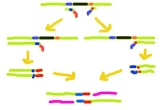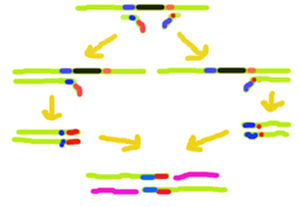
Overlap extension polymerase chain reaction
Encyclopedia
The overlap extension polymerase chain reaction (or OE-PCR) is a variant of PCR
. It is also referred to as Splicing by overlap extension / Splicing by overhang extension (SOE) PCR. It is used to insert specific mutation
s at specific points in a sequence or to splice smaller DNA fragments into a larger polynucleotide
.
To get higher yields, some primers are used in excess as in asymmetric PCR.
 To insert a mutation into a DNA sequence, a specific primer
To insert a mutation into a DNA sequence, a specific primer
is designed. The primer may contain a single substitution or contain a new sequence at its 5' end. If a deletion
is required, a sequence that is 5' of the deletion is added, because the 3' end of the primer must have complementarity to the template strand so that the primer can sufficiently anneal to the template DNA.
Following annealing of the primer to the template, DNA replication
proceeds to the end of the template. The duplex is denatured and the second primer anneals to the newly formed DNA strand, containing sequence from the first primer. Replication proceeds to produce a strand of the required sequence, containing the mutation.
The duplex is denatured again and the first primer can now bind to the latest DNA strand. The replication reaction continues to produce a fully dimerised DNA fragment. After further PCR cycles, to amplify the DNA, the sample can be separated by agarose gel electrophoresis, followed by electroelution for collection.
Efficiently generating oligonucleotide
s beyond ~110 nucleotides in length is very difficult, so to insert a mutation further into a sequence than a 110 nt primer will allow, it is necessary to employ overlap extension PCR. In OE-PCR the sequence being modified is used to make two modified strands with the mutation at opposite ends, using the technique described above. After mixing and denaturation, the strands are allowed to anneal to produce three different combinations as detailed in the diagram. Only the duplex without overlap at the 5' end will allow extension by DNA polymerase in 3' to 5' direction.
Following separation, the eluted fragments of appropriate size are subject to normal PCR, using the outermost primers used in the initial, mutagenic PCR reactions.
Polymerase chain reaction
The polymerase chain reaction is a scientific technique in molecular biology to amplify a single or a few copies of a piece of DNA across several orders of magnitude, generating thousands to millions of copies of a particular DNA sequence....
. It is also referred to as Splicing by overlap extension / Splicing by overhang extension (SOE) PCR. It is used to insert specific mutation
Mutation
In molecular biology and genetics, mutations are changes in a genomic sequence: the DNA sequence of a cell's genome or the DNA or RNA sequence of a virus. They can be defined as sudden and spontaneous changes in the cell. Mutations are caused by radiation, viruses, transposons and mutagenic...
s at specific points in a sequence or to splice smaller DNA fragments into a larger polynucleotide
Polynucleotide
A polynucleotide molecule is a biopolymer composed of 13 or more nucleotide monomers covalently bonded in a chain. DNA and RNA are examples of polynucleotides with distinct biological function. The prefix poly comes from the ancient Greek πολυς...
.
Splicing of DNA Molecules
As in most PCR reaction, two primers -one for each end- are used per sequence. To splice two DNA molecules, special primers are used at the ends that are to be joined. For each molecule, the primer at the end to be joined is constructed such that it has a 5' overhang complementary to the end of the other molecule. Following annealing when replication occurs, the DNA is extended by a new sequence that is complementary to the molecule it is to be joined to. Once both DNA molecules are extended in such a manner, they are mixed and a PCR is carried out with only the primers for the far ends. The overlapping complementary sequences introduced will serve as primers and the two sequences will be fused. This method has an advantage over other gene splicing techniques in not requiring restriction sites.To get higher yields, some primers are used in excess as in asymmetric PCR.
Introduction of Mutations

Primer (molecular biology)
A primer is a strand of nucleic acid that serves as a starting point for DNA synthesis. They are required for DNA replication because the enzymes that catalyze this process, DNA polymerases, can only add new nucleotides to an existing strand of DNA...
is designed. The primer may contain a single substitution or contain a new sequence at its 5' end. If a deletion
Indel
Indel is a molecular biology term that has different definitions in different fields:*In evolutionary studies, indel is used to mean an insertion or a deletion and indels simply refers to the mutation class that includes both insertions, deletions, and the combination thereof, including insertion...
is required, a sequence that is 5' of the deletion is added, because the 3' end of the primer must have complementarity to the template strand so that the primer can sufficiently anneal to the template DNA.
Following annealing of the primer to the template, DNA replication
DNA replication
DNA replication is a biological process that occurs in all living organisms and copies their DNA; it is the basis for biological inheritance. The process starts with one double-stranded DNA molecule and produces two identical copies of the molecule...
proceeds to the end of the template. The duplex is denatured and the second primer anneals to the newly formed DNA strand, containing sequence from the first primer. Replication proceeds to produce a strand of the required sequence, containing the mutation.
The duplex is denatured again and the first primer can now bind to the latest DNA strand. The replication reaction continues to produce a fully dimerised DNA fragment. After further PCR cycles, to amplify the DNA, the sample can be separated by agarose gel electrophoresis, followed by electroelution for collection.
Efficiently generating oligonucleotide
Oligonucleotide
An oligonucleotide is a short nucleic acid polymer, typically with fifty or fewer bases. Although they can be formed by bond cleavage of longer segments, they are now more commonly synthesized, in a sequence-specific manner, from individual nucleoside phosphoramidites...
s beyond ~110 nucleotides in length is very difficult, so to insert a mutation further into a sequence than a 110 nt primer will allow, it is necessary to employ overlap extension PCR. In OE-PCR the sequence being modified is used to make two modified strands with the mutation at opposite ends, using the technique described above. After mixing and denaturation, the strands are allowed to anneal to produce three different combinations as detailed in the diagram. Only the duplex without overlap at the 5' end will allow extension by DNA polymerase in 3' to 5' direction.
Following separation, the eluted fragments of appropriate size are subject to normal PCR, using the outermost primers used in the initial, mutagenic PCR reactions.

